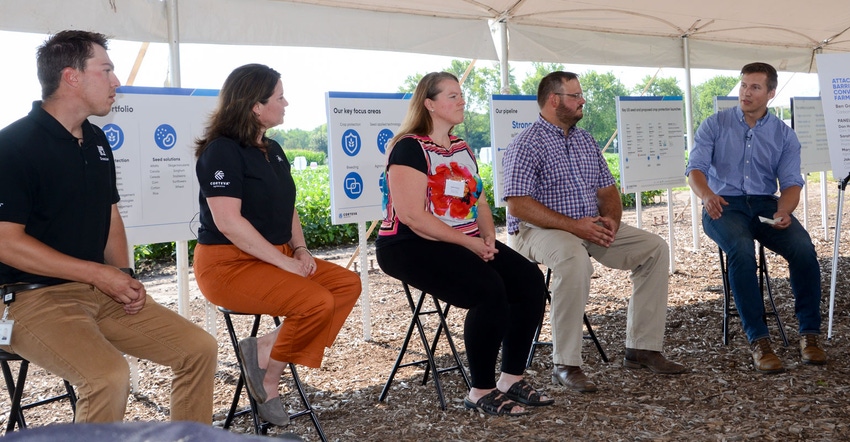July 22, 2021

Farmers are being bombarded with information about new programs that will pay them to enter into a carbon sequestration program. Major companies and cooperatives have made deals to sequester carbon in some measured way and get paid in return. But before you sign on the agreement’s dotted line, consider some factors.
During a recent panel discussion during a Corteva field day, the company brought in experts to discuss the issue. The company does offer its own carbon program, yet the discussion did turn toward some key steps to take ahead of committing your farm.
Dan Hansen, a corn, soybean, alfalfa farmer from Avoca, Iowa, shared that he had been approached may times. “My biggest concern, not with just Corteva’s carbon program, is how these programs will evolve or adapt. What does the fine print look like?” he asked.
And that’s the first step. It’s common to gloss over the finer details when accepting some agreement, but with carbon programs, that could cause trouble later. “Take the time to read that fine print, and determine what they’re asking for,” he said.
He said his challenge is the desire for fresh, no-till ground and fresh, cover crop ground. That’s not always possible, and in his part of Iowa, no-till has been in use for years. “It will be interesting as these markets develop to see if industry can pay for both sides of the fence,” he said.
Different programs offer their own approaches to opting in and opting out of practices they use to reward farmers for their carbon farming. So if farming conditions change, can a field that’s been enrolled in a program opt out? What if a farm needs to change a practice?
The challenge is a 10-year commitment. “Ten years is a long time in agriculture,” Hansen said.
For example, Corteva has a 10-year program, but a farmer can opt out after the first two years and annually after that. The initial two-year commitment is the base. Other programs work differently, and farmers must work with one that matches their business.
Mary Gumz, agronomy manager for Pioneer, noted that the rising use of practices such as no-till and strip till are encouraging. “These are not unproven changes,” she says. “We know when you transition to no-till, you face increased disease risk, increased crop residues — the seedbed stays colder, wetter longer. You can overcome those problems.”
Farmers taking on these new practices for the first time can turn to better disease control tools and hybrids with better seedling vigor, she said.
How do you get paid?
Seems like a question every farmer would ask. And there is confusion. When you hear the carbon value is $10 per acre, is that over the life of a 10-year contract? Or is that an annual payment? That makes a difference in the value of that program.
Sarah Carlson, strategic initiatives director for Practical Farmers of Iowa, has been working to help farmers fine-tune practices for years. That includes managing cover crops. Six years ago, the organization engaged groups including Cargill and ADM to be involved in a cost share. They’re not paying for carbon, she said. Instead, the group engaged farmers to use cover crops, and those groups came through with cost-share money to “de-risk” the practices being tested.
“Weed resistance is a major issue, and coverage crops are a mode of action in the soybean phase to keep those weeds out,” she noted.
PFI members do get some cost-share money for their work, which Carlson said does encourage them to take on the practices.
Most programs have an “additionality requirement,” which means you are adding that new practice in a year. That can go beyond cover crops to include strip till or no-till. But some of those practices involve significant equipment costs and management changes. The payment from a carbon program may help cover some of the cost. That’s a question that should be asked before signing on.
“These programs are just getting started,” said Ben Gordon, carbon and ecosystem services global portfolio lead for Corteva. “We’re working to maintain a more flexible payment, and we don’t want to take away a tool that a farmer needs.”
Added Jake Olson, carbon sales and support lead for Corteva: “You’re producing an asset, and people want to buy it. Where does the money come from? There are equal amounts of confusion and hype. What are you getting for a return when you sign up?”
He added that record keeping and data management are important parts of this new market. There are hoops to jump through, but you want someone who partners with you for it.
Gordon noted the programs are aimed at accelerating the practice or adoption of new practices, and getting involved in a program earlier may make sense. “There is a lot of upside we could see; we work on the agronomy first. But 10 years down the lane, will you have that option?” Gordon said.
Your comfort level matters, and these agreements can lock a farm in. The idea of “additionality” where you add a new practice to capture a premium must match or work with practices you already use. Essentially, read the fine print, and know what you’re being paid for and when. Simple questions that should be easily answered by any company representative.
About the Author(s)
You May Also Like






